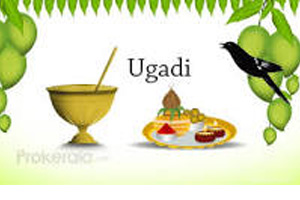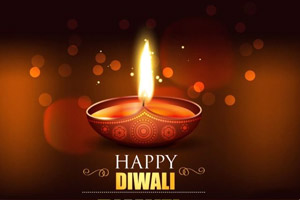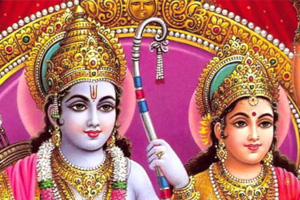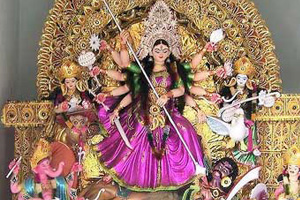
Ugadi is the New Year's Day for the people of Andhra Pradesh and also for the Telugu people all over the world. Those who live north of the Vindhya hills observe it as "Barhaspatyamana". People living to the south of the Vindhya hills observe it as "Sauramana" or "Chandramana".
It is believed that the creator of the Hindu pantheon Lord Brahma started creation on this day - "Chaitra Suddha Padhyami" or the Ugadi day. Also the calculations of the great Indian Mathematician Bhaskaracharya proclaim the Ugadi day as the beginning of the New Year, New month and New day. The onset of spring also marks a beginning of new life with plants acquiring new life, shoots and leaves. The vibrancy of life and verdant fields, meadows full of colourful blossoms signify growth, prosperity and well-being.
It is a season for raw mangoes spreading its aroma in the air and the fully blossomed Neem tree that makes the air healthy. Also, jaggery made with fresh crop of sugarcane adds a renewed flavour to the typical dishes associated with Ugadi.
"Ugadi Pachchadi" is one such dish that has become synonymous with Ugadi. It is made of new jaggery, raw mango pieces, Neem flowers and new tamarind. The inner significance of this preparation is to indicate that life is a mixture of good and bad, joy and sorrow and all of them have to be treated alike.

Diwali", the festival of lights, illuminates the darkness of the New Year's moon, and strengthens our close friendships and knowledge, with a self-realization!
Diwali is celebrated on a nation-wide scale on Amavasya - the 15th day of the dark fortnight of the Hindu month of Ashwin, (October/November) every year. It symbolizes that age-old culture of India which teaches to vanquish ignorance that subdues humanity and to drive away darkness that engulfs the light of knowledge. Diwali, the festival of lights even to-day in this modern world projects the rich and glorious past of India.
Every year on the dark nights of Diwali the sound of firecrackers announces the celebration of the favorite festival of Indians. Homes are decorated, sweets are distributed by everyone and thousands of lamps are lit to create a world of fantasy. Of all the festivals celebrated in India, Diwali is by far the most glamorous and important. Enthusiastically enjoyed by people of every religion, its magical and radiant touch creates an atmosphere of joy and festivity.
The ancient story of how Diwali evolved into such a widely celebrated festival is different in various regions and states of India. In the north, particularly in Uttar Pradesh, Punjab, Haryana, Bihar and the surrounding areas, Diwali is the day when King Rama's coronation was celebrated in Ayodhya after his epic war with Ravana, the demon king of Lanka. By order of the royal families of Ayodhya and Mithila, the kingdom of which Sita was princess, the cities and far-flung boundaries of these kingdoms were lit up with rows of lamps, glittering on dark nights to welcome home the divine king Rama and his queen Sita after 14 years of exile, ending with an across-the-seas war in which the whole of the kingdom of Lanka was destroyed.
On the day of Diwali festival, doorways are hung with torans of mango leaves and marigolds. Rangolis are drawn with different colored powders to welcome guests. The traditional motifs are often linked with auspicious symbols of good luck. Oil diyas are arranged in and around the house. Because of these flickering lamps, the festival has acquired its name : Dipawali or Diwali meaning 'a rows of lamps'. On this day, people buy something for the house or some jewelry for the women of the house. It is auspicious to be buy something metallic, such as silver.

Rama Navami is the day on which Lord Rama, the seventh incarnation of Lord Vishnu, incarnated in human form in the land of Ayodhya. He is the ardha ansh of Vishnu or has half the divinitive qualities of Lord Vishnu. The word "Rama" literally means one who is divinely blissful and who gives joy to others, and one in whom the sages rejoice.
Ram Navami falls on the ninth day of the bright fortnight in the month of Chaitra (April/May) (8 days after Yugadi) and coincides with Vasant Navratri or Chait DurgaPuja. Therefore in some regions, the festival is spread over nine days. This day, marking the birthday of Lord Rama, is also observed as the marriage day of Rama and Sita and thus also referred to as Kalyanotsavam.

Dussehra, also known as Vijayadashmi, is a major Indian festival celebrated on the tenth day of Ashvin month according to the Hindu calendar. This day falls in the month of September or October. The day culminates a 9 day fasting period of Navratri in the Hindu culture. The day also coincides with immersion of the idol of Goddess Durga. The day is celebrated to commemorate the killing of Ravana by Lord Rama. The day also celebrates the killing of demon Mahishasur by Goddess Durga. Dussehra celebration spreads the message of the victory of good over sin.
It is believed that the celebration of Dussehra started in the 17th century, when the king of Mysore ordered the celebration of the day on a grand scale. Ever since, the day is celebrated with great fervor and energy. There are a lot of mythological tales associated with the day. According to Ramayana,
Ravana was killed by Lord Rama on this day as revenge against the cruel act of kidnapping Goddess Sita by the former. Mythology also has it that Goddess Durga killed demon Mahishasura after a long spell of cruelty and oppression by Mahishasura. Another story associated with the origins of this day is the raining of gold coins. After Kautsa asked King Raghu for 140 million coins to give an offering to his Guru in return for his knowledge, Raghuraja went to Indra for help who then asked Lord Kuber to rain coins on the city of Ayodhya. After giving 140 million coins to his Guru, Kautsa distributed the rest to the people of Ayodhya.
The most famous Dussehra celebrations in India are those in the city of Mysore. Goddess Chamundeshwari is worshipped on this day and a grand procession of her idol is taken out across the city. Major buildings are decorated with lights and color across the city.
Other famous Dussehra celebrations in India include that of Kullu in Himachal Pradesh, Kolkata and Orissa, where the festival is preceded by week long celebrations. People visit the Pooja Pandals wearing new clothes, prepare traditional food at home and celebrate the festival with their friends and families. In most other parts of India, plays are organized across cities depicting the story of Ramayana which culminates in the killing of Ravana on this day. Statues of Ravana are burnt everywhere in India on Dussehra and in Delhi, the event is attended by political dignitaries in the Ramlila Maidan.